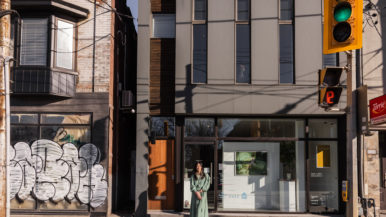Inside the amazing private art collection of photographer James Matthias

In the early 20th century, Rosedale’s Studio Building housed many Group of Seven painters. Today, the humble red-brick heritage building (visible along the Yonge subway line between Bloor and Rosedale stations) is home to art collector and underwater photographer James Matthias’s incredible store of hundreds of works of art and historical artifacts. Given its history, the building itself is like a part of the collection: Matthias’s late partner, lawyer-turned-painter Gordon MacNamara, purchased the space in 1948 (he died in 2006). Matthias spends most of the year on a 200-acre estate in north Uxbridge with an entire room dedicated to David Milne paintings (and an original Lawren Harris piece), but we caught up with him at his Toronto outpost for a peek into his collection.

A pair of cupboards flank the main couch in the entrance hall. This was MacNamara’s room during his final years, and the cupboards originally housed his clothes, but now they contain most of Matthias’s Oceanic artefacts. The Fijian tapa cloth hanging on the wall is made from mulberry bark.

These items come from Milne Bay, the southeast part of New Guinea. “It’s the only place I know that makes these sorts of things,” Matthias says. The knives are used to split betel gourds to access the chewy nuts within. The pestle-like objects on the lowest shelf are tapa “beaters,” which were used to flatten tree barks into usable swathes of tapa fibre. And the white tabua—the Fijian word for whale’s tooth—is from Vanuatu, and holds enormous ceremonial importance. Matthias bought some of these pieces from tribal art shows, while he carefully tracks down others on eBay from trusted sellers.

Auction houses and private collectors are always eyeing Matthias’s treasure trove for new finds, but Matthias admits he rarely parts with pieces he likes. “Gordon got this Buddha years ago, before I even existed in his life, and later on, he tried to sell it for $25,000,” Matthias says. “I said, ‘You get that back right now!’” More recently, a Sotheby’s agent estimated the value of the piece to be almost $250,000.

Tribal paraphernalia is scattered all over Matthias’s bedroom. The south wall houses his collection of yam masks, shields and ceramic pots, as well as a pair of photos of MacNamara (just left of centre). “Yam festivals are huge in New Guinea, and people go to great lengths to celebrate them,” Mattias says. “They would put masks on the yams and adorn them with ribbons, raffia, sometimes even shells or separate headdresses.” The solitary Balinese garuda, the figurine towards the far right, is a mythical bird that is associated with royalty in many Southeast Asian cultures.

Matthias’s bedside table houses his current reading material (including a Margaret Truman murder mystery), as well a figure of Saint Santos from the Philippines, which was gifted to him by a friend. The three pieces on the wall are more reminders of MacNamara: the topmost piece is one MacNamara himself painted, the wax-and-crayon mixture in the centre is a Henry Moore piece MacNamara bought while he was stationed in London in WWII, and the lowest piece is a Hockney Matthias bought while living in London in the 1960s. “It’s a gorgeous line drawing of Hockney’s boyfriend, Peter,” Matthias says. “Gordon had such great taste, and it’s so typical of Gordon and I to pick things that seem to have a conversation with each other.”

Prominent on Matthias’s desk are black carved figures called korwar, which are believed to house ancestral spirits; they were commonly depicted holding snakes to symbolize their ability to overcome challenges and signify strength for their families, and they would be placed in bags or the bows of boats to ensure safe journeys. The brown, oblong cylinder is a 100-year-old tobacco container completely etched with smoke, as opposed to ink. The carved black cuffs are bracers to wear while using bows and arrows. And the white shell bracelets are “sailor art,” carefully whittled and polished into shape by seafarers who had little do but carve while at sea.

In the drawing room, three cupboards house 15 trays of assorted fossilized objects and heritage pieces collected from the Solomon Islands, Gilbert Islands, Papua New Guinea and Fiji through both Matthias’s personal travels and adventures on eBay: spoons made of bone, tridacna shells, dog-tooth necklaces, pig tusks and so on. Many of these items would have been considered “bride price,” which means they would be amassed and offered as dowry. This tray of bracelets, arm cuffs and necklaces is from the Solomon Islands.

This totem-looking structure from New Guinea cost is actually a topper commonly attached to a haus tambaran, which is a traditional ancestral worship house in the eastern region. “This represents power and status,” Matthias says, “and it cost me $1,000 to ship home.” The figure lowest on the pole is a crocodile, an important symbol of vitality in the native culture. The wall-mounted artifacts surrounding the topper are a mixture of clubs and fertility carvings native to the Fijian islands, while the teddy bear leaning against the carving is Matthias’s very own pumpkin head doll from the 1950s, lovingly nicknamed “Trumpkinhead” for the moment.





